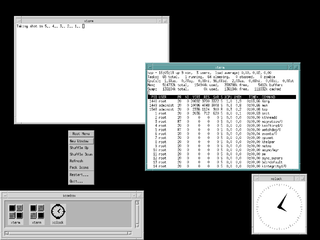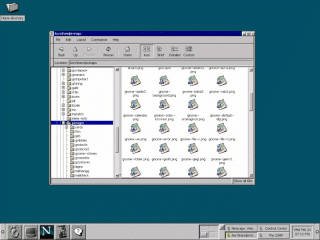
The Common Desktop Environment (CDE) is a desktop environment for Unix and OpenVMS, based on the Motif widget toolkit. It was part of the UNIX 98 Workstation Product Standard, and was for a long time the Unix desktop associated with commercial Unix workstations.
The Single UNIX Specification (SUS) is the collective name of a family of standards for computer operating systems, compliance with which is required to qualify for using the "UNIX" trademark. The core specifications of the SUS are developed and maintained by the Austin Group, which is a joint working group of IEEE, ISO JTC 1 SC22 and The Open Group. If an operating system is submitted to The Open Group for certification, and passes conformance tests, then it is deemed to be compliant with a UNIX standard such as UNIX 98 or UNIX 03.

OpenVMS, often referred to as just VMS, is a multi-user, multiprocessing and virtual memory-based operating system. It is designed to support time-sharing, batch processing, transaction processing and workstation applications. Customers using OpenVMS include banks and financial services, hospitals and healthcare, telecommunications operators, network information services, and industrial manufacturers. During the 1990s and 2000s, there were approximately half a million VMS systems in operation worldwide.

The X Window System is a windowing system for bitmap displays, common on Unix-like operating systems.

HP-UX is Hewlett Packard Enterprise's proprietary implementation of the Unix operating system, based on Unix System V and first released in 1984. Recent versions support the HP 9000 series of computer systems, based on the PA-RISC instruction set architecture, and HPE Integrity Servers, based on Intel's Itanium architecture.

Solaris is a proprietary Unix operating system originally developed by Sun Microsystems. After the Sun acquisition by Oracle in 2010, it was renamed Oracle Solaris.
Apollo/Domain was a range of workstations developed and produced by Apollo Computer from circa 1980 to 1989. The machines were built around the Motorola 68k family of processors, except for the DN10000, which had from one to four of Apollo's RISC processors, named PRISM.

Apollo Computer Inc., founded in 1980 in Chelmsford, Massachusetts, by William Poduska and others, developed and produced Apollo/Domain workstations in the 1980s. Along with Symbolics and Sun Microsystems, Apollo was one of the first vendors of graphical workstations in the 1980s. Like computer companies at the time and unlike manufacturers of IBM PC compatibles, Apollo produced much of its own hardware and software.
The Open Software Foundation (OSF) was a not-for-profit industry consortium for creating an open standard for an implementation of the operating system Unix. It was formed in 1988 and merged with X/Open in 1996, to become The Open Group.

In computing, Motif refers to both a graphical user interface (GUI) specification and the widget toolkit for building applications that follow that specification under the X Window System on Unix and Unix-like operating systems. The Motif look and feel is distinguished by its use of rudimentary square and chiseled three-dimensional effects for its various user interface elements.
Presentation Manager (PM) is the graphical user interface (GUI) that IBM and Microsoft introduced in version 1.1 of their operating system OS/2 in late 1988.

OPEN LOOK is a graphical user interface (GUI) specification for UNIX workstations. It was originally defined in the late 1980s by Sun Microsystems and AT&T Corporation.

NewWave is a discontinued object-oriented graphical desktop environment and office productivity tool for PCs running early versions of Microsoft Windows. It was developed by Hewlett-Packard and introduced commercially in 1988. It was used on the HP Vectras and other IBM compatible PCs running MS Windows.

HP 9000 is a line of workstation and server computer systems produced by the Hewlett-Packard (HP) Company. The native operating system for almost all HP 9000 systems is HP-UX, which is based on UNIX System V.

Domain/OS is the discontinued operating system used by the Apollo/Domain line of workstations manufactured by Apollo Computer. It was originally launched in 1981 as AEGIS, and was rebranded to Domain/OS in 1988 when Unix environments were added to the operating system. It was one of the early distributed operating systems. Hewlett-Packard supported the operating system for a short time after they purchased Apollo, but they later ended the product line in favor of HP-UX. HP ended final support for Domain/OS on January 1, 2001.

The Common Open Software Environment (COSE) was an initiative formed in March 1993 by the major Unix vendors of the time to create open, unified operating system (OS) standards.
Integrity Virtual Machines is software from Hewlett-Packard that allows multiple virtual machines to run concurrently on any Itanium server running HP-UX, notably the HPE Integrity Servers line. It is part of HP's Virtual Server Environment suite.

The HP Integral PC was a portable UNIX workstation computer system produced by Hewlett-Packard, launched in 1985 at a price of £5450. It was based on the Motorola 68000 microprocessor and ran the HP-UX 1.0 operating system.

GNOME 1 is the first major release of the GNOME desktop environment. Its primary goal was to provide a consistent user-friendly environment in conjunction with the X Window System. It was also a modern and free and open source software alternative to older desktop environments such as the Common Desktop Environment (CDE), but also to the K Desktop Environment (KDE). Each desktop environment was built-upon then proprietary-licensed widget toolkits, whereas GNOME's goal from the onset, was to be freely-licensed, and utilize the GTK toolkit instead.
















